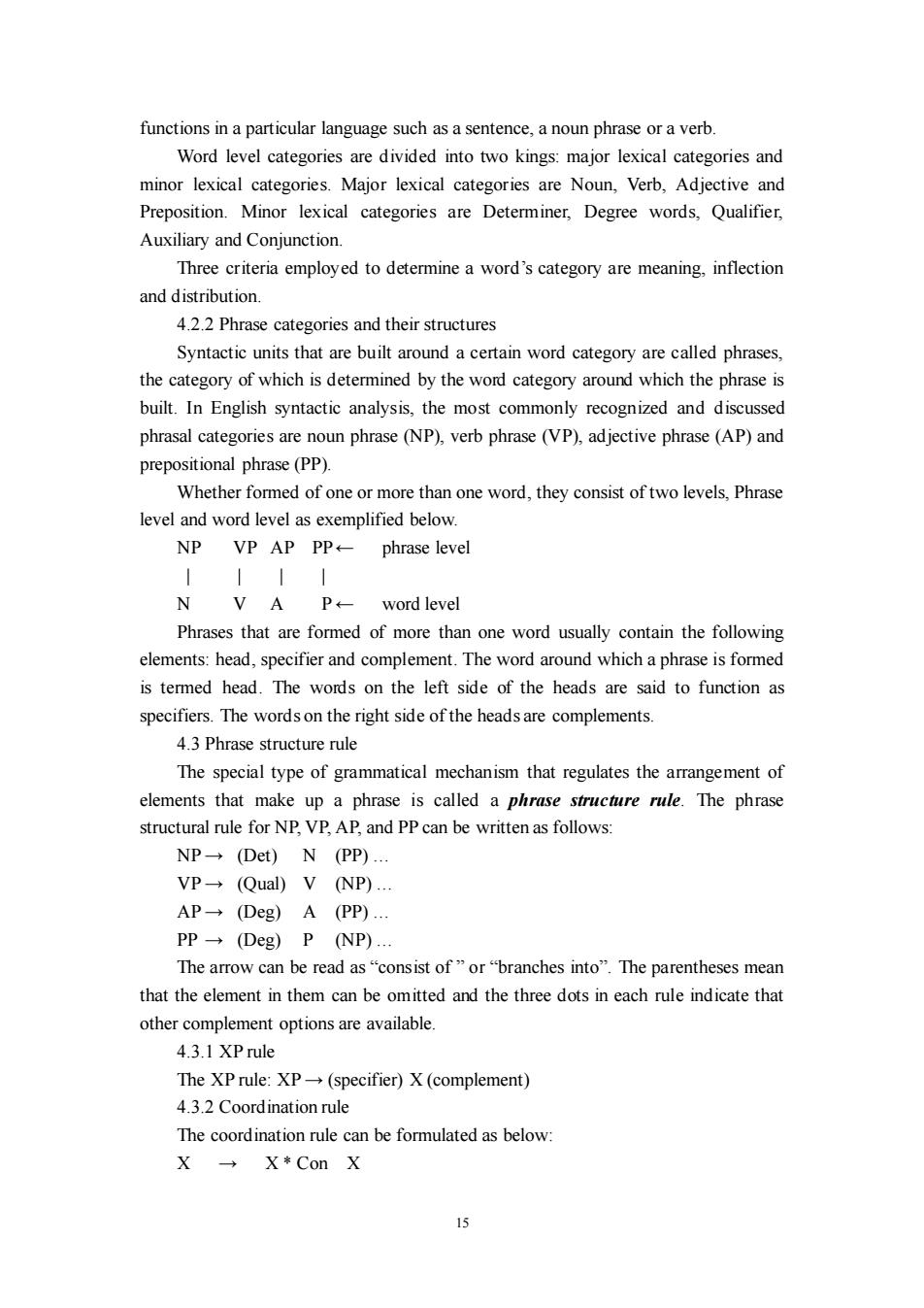正在加载图片...

functions in a particular language such as a sentence,a noun phrase or a verb Word level categories are divided into two kings:major lexical categories and minor lexical categories.Major lexical categories are Noun,Verb,Adjective and Preposition.Minor lexical categories are Determiner,Degree words,Qualifier, Auxiliary and Conjunction. Three criteria employed to determine a word's category are meaning.inflection and distribution. 4.2.2 Phrase categories and their structures Syntactic units that are built around a certain word category are called phrases. the category of which is determined by the word category around which the phrase is built.In English syntactic analysis,the most commonly recognized and discussed phrasal categories are noun phrase (NP).verb phrase (VP).adjective phrase(AP)and prepositional phrase(PP). Whether formed of one or more than one word,they consist oftwo levels,Phrase level and word level as exemplified below. NP VP AP PP- phrase level N P← word level Phrases that are formed of more than one word usually contain the following elements:head,specifier and complement.The word around which a phrase is formed is termed head.The words on the left side of the heads are said to function as specifiers.The wordson the right side ofthe headsare complements 4.3 Phrase structure rule The special type of grammatical mechanism that regulates the arrangement of elements that make up a phrase is called a phrase structure rule.The phrase structural rule for NP.VP.AP.and PP can be written as follows NP→(Det)N(PP). VP(Qual)VNP) AP→Deg)A(PP) Pp→(Deg)PNP). The arrow can be read as“consist of”or“branches into”.The parentheses mean that the element in them can be omitted and the three dots in each rule indicate that other complement options are available. 4.3.1 XP rule The XPrule:XP-(specifier)X(complement) 4.3.2 Coordination rule The coordination rule can be formulated as below X →X*ConX15 functions in a particular language such as a sentence, a noun phrase or a verb. Word level categories are divided into two kings: major lexical categories and minor lexical categories. Major lexical categories are Noun, Verb, Adjective and Preposition. Minor lexical categories are Determiner, Degree words, Qualifier, Auxiliary and Conjunction. Three criteria employed to determine a word’s category are meaning, inflection and distribution. 4.2.2 Phrase categories and their structures Syntactic units that are built around a certain word category are called phrases, the category of which is determined by the word category around which the phrase is built. In English syntactic analysis, the most commonly recognized and discussed phrasal categories are noun phrase (NP), verb phrase (VP), adjective phrase (AP) and prepositional phrase (PP). Whether formed of one or more than one word, they consist of two levels, Phrase level and word level as exemplified below. NP VP AP PP← phrase level | | | | N V A P ← word level Phrases that are formed of more than one word usually contain the following elements: head, specifier and complement. The word around which a phrase is formed is termed head. The words on the left side of the heads are said to function as specifiers. The words on the right side of the heads are complements. 4.3 Phrase structure rule The special type of grammatical mechanism that regulates the arrangement of elements that make up a phrase is called a phrase structure rule. The phrase structural rule for NP, VP, AP, and PP can be written as follows: NP → (Det) N (PP) … VP → (Qual) V (NP) … AP → (Deg) A (PP) … PP → (Deg) P (NP) … The arrow can be read as “consist of ” or “branches into”. The parentheses mean that the element in them can be omitted and the three dots in each rule indicate that other complement options are available. 4.3.1 XP rule The XP rule: XP → (specifier) X (complement) 4.3.2 Coordination rule The coordination rule can be formulated as below: X → X * Con X